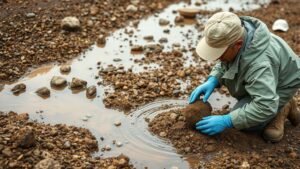The Importance of Ore Sample Testing Before Starting Full-Scale Recovery
The Importance of Ore Sample Testing Before Starting Full-Scale Recovery
Before embarking on large-scale mineral recovery operations, ore sample testing is a fundamental step that can make or break the success of a mining project. This process involves analyzing material from a mining site to ascertain its composition, value, and recovery potential. Understanding the significance of thorough ore sample testing can provide investors, operators, and scientists with essential insights that could lead to informed decision-making and optimized recovery processes.
Understanding Ore Sample Testing
Ore sample testing encompasses various laboratory techniques aimed at assessing the mineralogy, metal content, and grade distribution of ore. Key methods include fire assay, X-ray fluorescence (XRF), and inductively coupled plasma mass spectrometry (ICP-MS). Each technique can provide specific insights depending on the type of ore and the desired elements for recovery.
Minimizing Financial Risks
Conducting thorough ore testing prior to large-scale recovery can significantly reduce financial risks. Without comprehensive sampling, companies might overestimate the ores value, leading to inflated project costs and potential financial losses. For example, a mining operation that previously dealt with copper ore in a certain region attempted to scale up based on initial samples that indicated high mineral content. Subsequent, more extensive testing revealed that the actual grade was significantly lower than expected, resulting in a loss of millions due to overproduction and unmanageable operational costs.
Optimizing Resource Management
A well-executed ore sampling strategy allows mines to optimize their operations. By understanding the characteristics and distribution of minerals, companies can effectively plan extraction methods tailored to the ore type. For example, the use of heap leaching for gold recovery is only efficient when indicated by preliminary tests that demonstrate favorable recoverability rates. Alternatively, a company may determine that more intensive processing techniques are warranted to extract valuable metals based on ore sample characteristics.
Guiding Technological Investments
Ore sample testing also influences decisions regarding technological investments. High-quality data can help management decide whether to upgrade equipment or processes to meet the needs of ore with specific traits. For example, a mine with a high percentage of refractory gold may need to invest in autoclaves or pressure oxidation processes that could bolster recovery rates. Without adequate preliminary testing, such investments could lead to suboptimal expenditure and wasted resources.
Regulatory Compliance and Environmental Risk Management
Meeting regulatory standards is another crucial component of ore testing. Many jurisdictions require comprehensive environmental assessments as part of the mining permit application process. By conducting thorough ore sample testing, mining companies improve their understanding of potential environmental impacts, allowing them to implement mitigation strategies proactively. For example, testing might show that certain elements of the ore can lead to toxic runoff, prompting the need for additional safety measures to safeguard local ecosystems.
Case Studies Highlighting the Value of Testing
- Example 1: The Ashanti Goldfields Corporation in Ghana improved its recovery by transitioning to a targeted mining approach following detailed ore sample analysis. This realignment based on testing improved gold recovery rates significantly, leading to increased profitability.
- Example 2: A copper mining operation in South America faced reduced output due to unexpected metal grades discovered through rigorous sampling. By adjusting their mining strategy to focus on areas with higher ore density reflected in the test results, they were able to recover losses rapidly.
Conclusion and Actionable Takeaways
To wrap up, ore sample testing is not merely a preliminary task but a critical component of the entire mining process. It serves to minimize financial risks, optimize resource management, guide technological investments, and ensure regulatory compliance. For mining companies, prioritizing ore testing before full-scale recovery can lead to significant advantages in operational efficiency and profitability.
Companies should not overlook this valuable step. Instead, they should develop a robust protocol for ore sampling and testing that includes:
- Comprehensive sampling plans tailored to the site characteristics.
- Utilization of multiple testing methods to gain a complete understanding of ore properties.
- Regular updates and reevaluations of the sampling strategy as operations progress.
By adopting these practices, mining operations can enhance their potential for success in the challenging landscape of mineral recovery.


